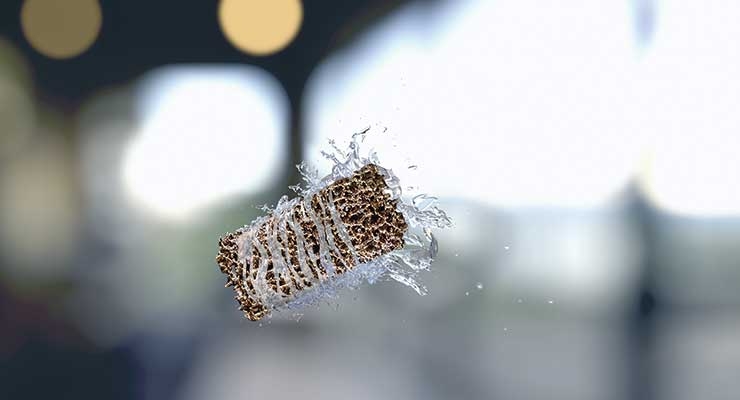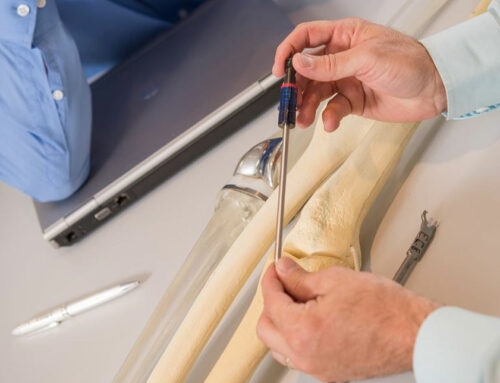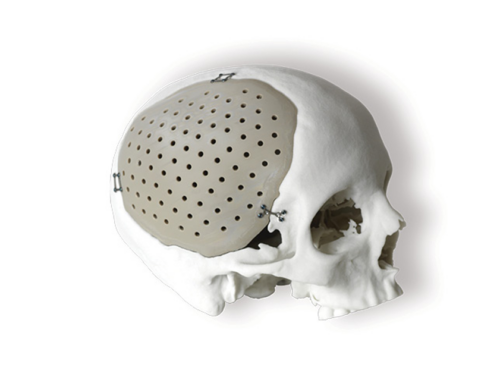Orthopedic and spinal device surface treatments are necessary for a variety of aesthetic and functional improvements.
2019, May 23 | Posted in ODT by Sam Brusco, Associate Editor
Titan Spine spent years developing its U.S. Food and Drug Administration (FDA)-cleared proprietary nanoLOCK surface technology, which the company applies to a number of its Endoskeleton interbody fusion devices. nanoLOCK surface technology incorporates a significant amount of the microscopic and nanoscopic features found on natural bone via a combination of roughened topographies at the macro, micro, and nano levels. This promotes the natural production of bone morphogenic proteins, allowing a faster, more robust fusion process. At the time of writing, nanoLOCK is the first and only FDA-cleared nanotechnology device for the spine and the only technology with access to the Centers for Medicare and Medicaid Services (CMS) new technology code for nanotextured interbody devices.
Last May, a review of research featured in the journal SPINE supporting nanoLOCK detailed the notable differences demonstrated among various types of spinal implant technologies. These included those developed through additive (coating or 3D printing) methods, subtractive methods, and various materials that include polyetheretherketone (PEEK), titanium, and combination plasma-sprayed materials. The review revealed that Titan Spine’s titanium nanotextured surface, engineered through the company’s proprietary subtractive process, directly interacts with cells to generate specific cellular responses driving bone production that porous or micron-scale implant surfaces cannot. It also showed that the combination of the implant material and nano-scale surface is critical to stimulate bone formation.
nanoLOCK’s success prompted medtech behemoth Medtronic to begin proceedings to purchase Titan Spine on May 9. Acquiring the privately-held titanium spine interbody implant and surface technology company padded Medtronic’s already robust Spine portfolio of implants, instruments, enabling technologies, and biologics.
“Titan Spine has pioneered the spine implant surface technology category over the past several years,” Medtronic senior VP and Spine division president Jacob Paul told the press. “We feel that surface-enhanced titanium implants combined with our comprehensive biologics portfolio can have a positive impact on patient outcomes in spinal procedures.”
Nanotexturing is one of the latest surface modification strategies to improve clinical outcomes for orthopedic implants. It is used specifically to promote osseointegration—bone ingrowth or ongrowth—for more successful implantation. It is one of many different surface treatments applied to ensure orthopedic implants and parts are clean, aesthetically pleasing, and optimally functional.
Mass finishing, for example, comprises a group of manufacturing processes that allow large quantities of parts to be simultaneously finished, with the goal to burnish, deburr, clean, radius, de-flash, descale, remove rust, polish, brighten, surface harden, prepare parts for further finishing or break off die cast runners. Tumble finishing—an action comparable to rocks tumbling down a steep hill—efficiently deburrs parts by rotating them in a barrel with water, abrasive media, and a compounding agent. Vibratory finishing involves placing parts, media, and compounds in a vibratory bowl for a similar effect. Generally, vibratory finishing is more popular because of its compatibility with automation and ability to finish very large or delicate parts.
“Mass finishing and shot blasting have been playing an important role in placing the finishing touch on orthopedic devices,” stated Bernhard Kerschbaum, CEO of Rosler Metal Finishing USA, a Battle Creek, Mich.-based provider of metal surface finishing and preparation. “Mass finishing methods, especially drag finishing, create perfect, blemish-free surface finishes with Ra [surface roughness] values of less than 1 microinch (i.e., knee femorals, femoral heads, the inside of acetabular cups).”
Drag finishing, which pulls components precisely through the media mass, is a popular choice for orthopedic devices and parts mainly because the parts do not touch each other during the process, and the technique produces the same high finishing quality from day to day. In drag finishing systems, parts are mounted to a carousel (which is equipped with multiple workstations), then are dragged through a circular work bowl filled with grinding or polishing media. Drag finishing systems are also usually designed around customers’ requirements, meaning there is a wide range of different drag finishing equipment available.
Shot blasting is a surface finish technique that involves rapidly impacting the surface of an object with a controlled stream of abrasive shot material. The process prepares metal parts for further processing like painting or coating. This step is necessary to ensure the coat adheres properly to the part. It also cleans off contaminants, removes metal oxides, and deburrs the surface.
Shot peening, a subset of shot blasting, is a cold work process to finish metal parts to prevent fatigue and stress corrosion failures and prolong the part’s product life. In shot peening, the part’s surface is bombarded by a small spherical shot. This shot acts like a peen hammer, dimpling the surface and causing compression stresses under the dimple. As the part continues to be struck by the media, multiple overlapping dimples form on the surface. The resultant surface compression strengthens the metal, ensuring the finished part will resist fatigue failures, corrosion fatigue and cracking, and galling and erosion from cavitation.
“Shot blasting, on the other hand, will generally make a surface rougher,” continued Kerschbaum. “That is why it is frequently used to prepare a surface for subsequent plasma coating (i.e., hip stems, the outside of acetabulums). Shot blasting, in the form of shot peening, is also used for extending the longevity of orthopedic implants by creating residual compressive stress on the component surface (i.e., bone screws, spinal rods, hip stems). Shot peening, along with improved materials, has no doubt contributed to extending the longevity of certain orthopedic implants well beyond 20 years.”
Electropolishing, which is also known as electrochemical polishing, anodic polishing, or electrolytic polishing, is an electrochemical process to remove material from a metallic workpiece. This process improves a metal’s surface finish by reducing surface roughness and leveling micro-peaks and valleys in the material. The method is used to polish, passivate, and deburr metal parts. Because of its ease of operation and utility in polishing irregularly shaped objects, electropolishing has become a standard method to produce semiconductors. And because it can also be used to sterilize workpieces, electropolishing plays a crucial role in the food, pharmaceutical, and medical device industries.
Passivation is a metal finishing operation similar to electropolishing that many industries specify for parts. The passivation chemical process is intended to increase the corrosion resistance of stainless steel parts. Passivating stainless steel removes free iron and foreign materials from the part’s surface, producing a clean and more corrosion-resistant part.
“Electropolishing and passivation are very popular for orthopedic devices,” noted Scott Potter, VP of sales at Able Electropolishing, a Chicago, Ill.-based firm that provides metal finishing services to companies from a wide variety of industries that use conventional and specialty metal alloys. “Electropolishing offers multiple benefits for achieving the desired finish. In one process, you can deburr, improve fatigue life, improve surface finish, improve corrosion resistance, and passivate. Passivation removes free iron and other foreign matter from the surface and can be performed with nitric or citric acid.”
Medical manufacturers like electropolishing because it is one single process that can effectively achieve a smooth, burr-free, corrosion-resistant, clean finish. The process can be used for both surgical tools and implantable items. Electropolishing is used to ensure that staples fire freely from a surgical stapler and don’t jam and removes any heat tint from heat treating. Saw blades used in orthopedic procedures can also be electropolished to remove burrs and laser slag from laser-cut saw blades. Implants made from Nitinol and titanium can also be made more biocompatible via electropolishing. The process removes the outer metal skin along with surface contaminants—by doing this, the passive, oxygen-rich surface effectively inhibits bacterial growth and slows corrosion.
“An electropolished surface will not peel or abrade like a coated or plated surface,” Potter continued. “The outer skin of metal is removed, exposing the base material and returning the surface to the original mill condition prior to introducing carbon steel from tooling and other contaminants present in the manufacturing process.”
Anodizing is an electrolytic passivation process to increase the thickness of the natural oxide layer on the surface of metal parts. It is named as such because the treated part forms the anode electrode of an electrolytic cell. Anodizing boosts resistance to corrosion and wear and allows better adhesion for paint primers and glues than bare metal. Anodizing can also be used for cosmetic effects, either with thick porous coatings to absorb dyes or thin transparent coatings to add interference effects to reflected light.
Orthopedic device materials like aluminum and titanium can benefit significantly from an anodizing process. Anodized aluminum alloys exhibit increased corrosion resistance, lubrication, and adhesion. Titanium alloy anodization produces anti-galling and wear resistant properties, and can also be used cosmetically to achieve a spectrum of colors.
“Surface treatments performed by Danco, such as Titanium Anodize, Aluminum Anodize, and Low Friction Chrome coating continue to be a popular choice for orthopedic implants and instruments,” commented Tim Zentz, general manager at Danco Anodizing, a Warsaw, Ind.-based provider of surface preparation, anodizing, and identification techniques for metal parts. “Our consistent and validated processing makes this final step effortless for the medical device market.”
Spinal interbody cages have been used since the late 1980s to aid bone fusion in a variety of spinal disorders. These cages are used to restore intervertebral height, allow bone graft containment for arthrodesis, and restore anterior column biomechanical stability. They have become a relatively highly successful means of achieving fusion because they bring about less postoperative pain, a shorter hospital stay, fewer complications, and higher rates of fusion than bone graft only spinal fusion.
PEEK has traditionally been the material of choice for interbody cages because the polymer is hydrophobic and bioinert, making it a useful implantable material, and because the material’s modulus is very close to that of bone. PEEK is still in high demand for spinal implants but has the troubling inability to integrate with surrounding bone effectively. Instead, PEEK implants form a scar tissue capsule that can reduce the implant’s stability and increase the chance of implant migration. PEEK implant osseointegration, therefore, needs assistance from a surface coating of osteoconductive material like titanium or hydroxyapatite (HA). Within the spine market, a number of the leading implant companies have launched coated PEEK interbody devices.
The rise of additive manufacturing techniques has provoked another revolution in spinal cage technology because it facilitates fabrication of a porous titanium implant, which is ideal for bone integration because the implant’s topography mimics cancellous bone. The technique is not so much a surface treatment as surface texturing facilitated by the process of additive manufacturing. A number of them already exist on the market—Stryker’s Tritanium PL (posterior lumbar) cage, Medtronic’s ARTiC-L cage, and NuVasive’s Modulus XLIF cage being just a few of the options available.
“There is currently a trend in spine to create devices that osseointegrate with the bone to get true fusion and less revisions,” pointed out Ulf Brogren, president of Austin, Texas-based Promimic U.S. Inc., a biomaterial company that develops and markets an implant surface that accelerates osseointegration. “The shift from traditional PEEK implants toward 3D printing and coatings will continue to grow. Looking at other segments, there is definitely also a trend towards cementless devices in total joint replacement. Surface modification and thin coatings will be crucial for these devices.”
As Brogren alludes to, interest in uncemented total knee replacement has also ballooned in recent years. Thanks to advances in prosthetic design, instrumentation, and operative technique, cementless knees have seen a revival. The potential benefits of using cementless knee implants are many: shorter operating room time, preserving bone stock, ease of revision, and elimination of cemented fixation complications like third body wear and retained loose fragments.
Recently ceramic composites have begun to find more use in prosthetic hips and knees. These have shown minimum wear and they are excellent in total hip replacement in particular because they are highly resistant to scratching and exhibit better wettability as compared to cobalt-chromium alloy. The biologic response to debris generated from ceramic bearings is also less aggressive. A porous titanium coating is typically applied to a ceramic surface to promote osseointegration.
“We’re most excited about the solutions able to realize bio-material components,” mused Francesco Robotti, scientific marketing manager for Lincotek Medical (former Eurocoating), Pergine Valsugana, Italy-based provider of thermal plasma spray (TPS) coatings for implantable orthopedic and dental applications. “It’s a matter of balance. For example, titanium porous coating coatings applied to ceramics have to respect severe constraints—they must be very respectful of the substrate and establish a good enough adhesion and cohesion for the intended use. Results recently achieved will enable conceiving and delivering new devices, potentially enabling less invasive surgeries for patients before exclusion because of lack of viable alternatives. As examples, we are starting to see cementless knees with ceramic surfaces or cementless ceramic resurfacing components.”
The need for osseointegration—the direct structural and functional connection between living bone and the surface of a load-bearing implant—is crucial for successful long-term orthopedic and spinal device implantation. The process was first observed in 1940 when researchers implanting titanium in an animal discovered that the material tended to fuse with bone. In addition to its strength and hardness, its capacity to promote bone ingrowth makes titanium the material of choice even in today’s load-bearing implants. Osseointegration science also factors heavily into modern implant dentistry.
As previously mentioned, PEEK was the material of choice for spinal interbody cages until the recent rise of textured metal implants forged by additive manufacturing. But since PEEK is hydrophobic and bioinert, its surface must be modified to promote fusion with bone. Many OEMs have started to coat PEEK with plasma-sprayed HA or porous titanium. This has its own set of difficulties because materials with different mechanical properties and hardness are combined. In the case of plasma sprayed HA onto PEEK, a stiff and brittle ceramic material is applied to a soft and flexible substrate. Both materials will respond differently under stress, which can cause delamination or crack formation. But companies specializing in surface treatment have developed coating materials and techniques to address some of these concerns.
“Osseointegrative coatings are very popular because they give specific biocompatibility properties to functional parts,” said Robotti. “Very often, the functionality is reached using metals like stainless steel or cobalt-chromium (CoCr) alloys or smooth titanium, ceramics like ZTA (zirconia-toughened alumina) or polymers like polyethylene or PEEK (polyetheretherketone). These biomaterials show excellent mechanical and/or wear characteristics. However, they are bioinert. In these cases, applying a coating of different nature or morphology increases the osseointegrative potential of the surface without impairing the functional tasks carried by the bulk material.”
Mass finishing, air blasting, and wet blasting equipment can also be used for surface modifications to enhance osseointegration. Air blasting and wet blasting provide a roughened surface on the implant, allowing bone growth to occur. Usually, Ra value for a surface altered with these processes is greater than 200 microinches. This can be achieved with several different abrasive blast media. This is nothing new but is crucial for orthopedic manufacturers to remember.
“For the bone contacting surface, it’s important that surface should promote bone ingrowth or ongrowth for better attachment,” explained Parimal Bapat, Ph.D., a research engineer at Orchid Orthopedic Solutions, a Lansing, Mich.-based provider of orthopedic medical device outsourcing, offering contract design and manufacturing services. “In the case of bone ingrowth, a porous coating made using a sintering process or plasma spray process is most commonly used, as these porous structures allow the bone to grow into the surface. In the case of bone ongrowth, a roughened surface or HA coated surface does the job.”
For example, Orchid’s Asymmetrix Type 1 Rough Coating features an irregular bead coating structure with the added features of an extremely rough surface and increased porosity to promote osseointegration. Its commercially pure irregular shaped titanium powder, which conforms to ASTM F 67 and ASTM 1580 is used to coat Ti6Al4V (titanium alloy) components. Three coating layers are applied to the implant surface to control the coating thickness. Traditional vacuum sintering conditions similar to spherical bead coatings are utilized for Asymmetrix.
“Along with a porous surface, it’s also important to have rough surface for better bone attachment,” Bapat continued. “Our Asymmatrix coating is a sintered bead coating, but uses irregular beads to create a highly roughened surface with high porosity required for good bone ingrowth.”
Osseointegration can also be promoted with a textured, somewhat rougher surface finish. For some implants, applying a plasma coating to the areas that must quickly and effectively combine with bone tissue does the trick.
“Frequently, a shot blasting process with relatively coarse blast media will achieve the textured surface finish required for osseointegration,” explained Kerschbaum. “In this case, the blast media choice is critical to ensure the implant surface is not contaminated with blast media inclusions, which could result in disastrous chemical reactions in the body. For this reason, mostly mineral blast media are utilized.”
HA coatings have become popular for orthopedic applications in particular because up to half of human bone is composed of HA. HA is already used as a filler to replace amputated bone. HA coatings for orthopedic devices are becoming increasingly popular over titanium coatings because of enhanced osseointegrative capability due to augmented mimicry to bone.
Promimic’s HAnano Surface promotes osseointegration via a 20 nm thin coating that contains HA. The coating has been shown to boost implant stability and promote bone ingrowth into porous materials and 3D structures, combining high wettability and optimal surface chemistry with optimized nano-roughness. The 20 nm surface assists new bone to grow directly into the micrometer topography on the implant surface. HAnano Surface can be applied to a variety of substrates, including metals, ceramics, and PEEK.
“There is a shift from thicker coatings to thin coatings and surface modifications,” noted Brogren. “These thinner coatings and modifications have shown to improve osseointegration of the device itself versus simply onto a thick coating. This will decrease the risk for the device since a thicker coating can crack and flake off. Also, these new surface modifications like our HAnano Surface allow for the possibility to surface modify new types of devices that would be impossible with plasma spraying.”
There is also a rising demand for new types of coatings and surface modifications adopted to 3D printed implants as additive manufacturing techniques continue to mature. Treating the surface of 3D printed orthopedic implants brings a variety of technical challenges. Additively manufacturing a component requires building layer upon layer of material, and in the case of complex parts, a support structure preventing collapse during manufacturing must be created as well. And for metal components, sintered metal particles embedded in the component surface must be removed.
“Danco has been in communication with many OEMs about the potential challenges of surface modifying 3D printed devices,” Zentz informed ODT. “3D printed devices typically have lattice patterns that do not lend themselves to proper removal of contact materials (i.e., chemical entrapment).”
“As far as surface improvement is concerned, no doubt the biggest technological challenges will be with 3D printed components,” predicted Kerschbaum. “Here we may see completely new combinations of different technologies like chemical/electrochemical and mechanical finishing methods.”







